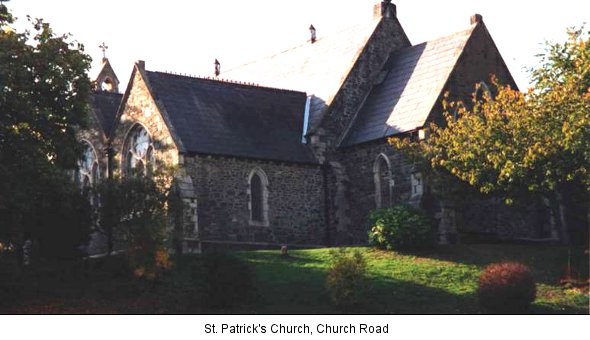Journal Volume 3 2000
Places of Worship in Greystones
A Heritage-Day Itinerary
Commentary by Séamas Ó Saothraí
St Patrick's Church of Ireland
St Patrick's Church of Ireland was the first place of worship in Greystones, though there had been from early times a chapel in Rathdown, about half-a-mile away. The original part of the edifice we are looking at was erected in 1857 on a site presented by the La Touche family of Bellevue, Delgany, who also bore a large share of the construction cost. But the building, for want of an endowment to support a rector, remained unconsecrated until 1864. It was with the extension of the railway line to Greystones in 1856 (one-source gives 1855) that the population of the area began to increase. St Patrick's church had to be extended in 1875, in 1888 and again in 1898. In the Church of Ireland division Greystones was now a separate parish, independent of Delgany, of which it had been a part. I don't feel competent to describe the building - or any building, for that matter - architecturally; but it is plain to ah who look at it that its fabric is in remarkably good condition, considering that the earliest part of it dates from 1857.

A building such as this becomes a church only when worshippers frequent it - by the people of God. So a church is really about people, isn't it? And this church has a large congregation, as has the neighbouring Christ Church in Delgany. One family who worshipped God here just over a hundred years ago and whose descend- ants are still here was that of the Doyles. Try to picture the heart-rending scene when the bodies of John, William and Herbert Doyle, all three of them belonging to the one family, were received here by the then rector, whose sad duty it was to preside at their obsequies. They were drowned in the harbour during a storm on Friday night, 14 October 1892, while on an errand of mercy. An anonymous broadside ballad of the time described them as 'The Heroes of Greystones'.
A former rector of Greystones, the Revd Dr Edward Francis Butler Moore, who was later archdeacon, was raised to the episcopate and consecrated bishop of Kilmore. He and his wife, formerly Miss Olive Scott of the Bray clerical family, retired to Kilcoole, but still worshipped here. Mrs Moore, who died on 17 January 1997, was the last surviving daughter of Canon George Digby Scott (1865-1950), rector of Bray. His history of this entire district, The stones of Bray and the stories they can tell of ancienttimes in the barony of Rathdown (1913; reprinted 1983) has never been superseded. Mrs Moore's mother, Charlotte Jessy Scott (1862-1951), was a daughter of Sir William Barrington, Bart. Her grandfather, Chancellor James George Scott, who died in 1912, was 'the last vicar of Bray'. Her maternal great-grandfather was the Revd William Cleaver, rector of Delgany, whose father Euseby (himself the son of a clerical schoolmaster and younger brother of an English bishop) was archbishop of Dublin. William's son, Euseby Digby Cleaver, was born in Delgany, graduated at Oxford and took orders in the Church of England. He was a Gaelic enthusiast and a generous benefactor of the language movement, and he was first vice-president of the Gaelic League in 1893. Bishop Moore did not long survive his wife. Their elder son James is now bishop of Conner and their younger daughter Audrey is a Greystones resident.
A Greystones rector of earlier date, the Revd Edward Stephen Daunt, who died in 1928, laboured here for forty-six years. Described as 'a man of great brotherliness and evangelical spirit', he gave the infant Presbyterian congregation the use of what is now the old but was then the new schoolhouse in 1885, while their meeting-house was at no more than planning stage. Just over a century later the present rector, the Revd Edgar John Swann, afterwardscanon and now archdeacon of Glendalough, and his select vestry, gave the Presbyterians the use of their church for over an hour each Lord's Day for several weeks, while their own place of worship was being refurbished, about the time of their centenary (1987). These acts of Christian kindness are not readily forgotten.
The rectory, a substantial family residence, is in the church grounds. I don't know the date of its erection. There is a memorial plaque on the inside south wall of this church to those Greystonians who served inthe two world wars - 1914-18 and 1939-45. To commemorate the centenary of the consecration of the church a booklet by Samuel Alien French, solicitor, whose residence was Orahova on Church Road and who died on 29 April 1978, was printed locally, with a foreword by the then rector, the Revd Leslie Aiden Elliott, afterwards canon. Entitled Greystones 1864-1964, it is long out of print. This booklet contains much local as well as parish history; but we still await a comprehensive chronicle of the parish, as well as a general history of the town and its environs. Samuel French's interesting booklet may be consulted in Greystones library, where facsimile copies are available for inspection.

